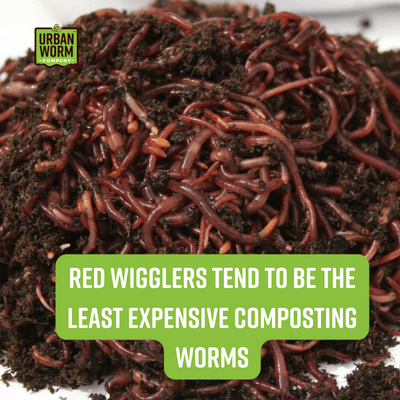The Ultimate Guide to Taking Care Of Red Wigglers in Your Yard
Taking care of red wigglers in your yard is an important part of lasting composting techniques that can significantly boost soil wellness and fertility. Recognizing their details environment needs, nutritional preferences, and upkeep demands is vital for promoting an efficient vermicomposting environment. As we check out the nuances of establishing a helpful area and the most effective feeding methods, the effects of these practices will come to be increasingly noticeable. The trip does not end with standard treatment; there are sophisticated strategies that can even more enhance your results, welcoming a deeper expedition into the globe of vermiculture.
Understanding Red Wigglers

Red wigglers are characterized by their reddish-brown pigmentation and fractional bodies, which can grow up to 4 inches in size. They possess a high reproductive rate, generating cocoons that include multiple embryos, substantially enhancing their populace in appropriate environments. Where to buy red wigglers. Their physiology allows them to tolerate various dampness degrees, although they thrive in damp problems, ideally between 60 ° F and 80 ° F.))

Setting Up the Environment
Developing an optimal habitat for red wigglers is important for optimizing their composting performance and general health and wellness. Red wigglers grow in a moist, dark atmosphere with a temperature level range of 55 to 77 levels Fahrenheit.
When selecting a container, choose one that is well-ventilated to permit air circulation while stopping excess moisture loss. Plastic containers, wooden boxes, or specialized worm containers are all effective alternatives. The base of the container should have drain holes to stop water accumulation, which might result in anaerobic conditions harmful to the worms.
Consistently examine the wetness level of the bed linens, and add water as essential to maintain the ideal wetness. By establishing these problems, you will create a thriving environment for your red wigglers, encouraging effective composting and healthier worm populations.
Picking the Right Food
Selecting the appropriate food for red wigglers is critical for their wellness and composting efficiency. These worms grow on a balanced diet plan that includes a variety of natural materials.
Red wigglers prefer food that is chopped or shredded, as this raises surface and advertises much more efficient digestion. Furthermore, presenting food in percentages avoids overfeeding, which can lead to anaerobic problems damaging to worm health and wellness. Monitoring find this the worms' consuming practices can additionally offer understandings; if the food is consumed rapidly, consider progressively increasing the quantity.

Preserving Moisture and Temperature
A well balanced diet plan is only part of the formula when it comes to making sure the wellness of red wigglers; maintaining proper dampness and temperature is just as vital. Red wigglers flourish in a wet atmosphere, preferably between 70-85 ° F(21-29 ° C) This variety supports their metabolic processes and boosts their ability to break down raw material effectively.
Conversely, extreme moisture can produce anaerobic problems, which may hurt the worms and generate undesirable odors. Consistently examining the wetness material and readjusting as required is important for a flourishing worm population.
To reduce temperature extremes, take into consideration making use of insulation for outdoor containers or transferring the container to a shaded or temperature-controlled area. By very carefully handling both dampness and temperature, you develop an optimum setting for red wigglers, enhancing their productivity and total wellness.
Harvesting Compost and Treatment Tips
Gathering compost from your red wigglers is a rewarding process that not only advantages your garden but additionally enhances the efficiency of your worm bin - Where to buy red wigglers. To begin, select a harvesting method that matches your arrangement-- whether it's the tray, pyramid, or typical container approach. Each approach allows for the separation of garden compost from worms effectively
To collect, you can delicately dig deep into the compost from one side of the container, enabling worms to migrate to the undisturbed side. You can utilize light to motivate worms to tunnel deeper, making it much easier to accumulate the completed garden compost.
Care pointers after harvesting include renewing your worm bin with fresh bedding and food scraps to keep a healthy and balanced worm population. Guarantee that the dampness and temperature level levels stay ideal, and frequently keep track of for any type of indicators of distress amongst the worms. By following these methods, you'll ensure a sustainable cycle of garden compost manufacturing that enhances your yard.
Conclusion
In final thought, the successful treatment of red wigglers necessitates a comprehensive understanding of their habitat, dietary requirements, and environmental problems. Establishing an appropriate habitat with correct ventilation and moisture degrees is important for cultivating their health and productivity.
By developing these problems, you will certainly produce a thriving environment for your red wigglers, encouraging reliable composting and healthier worm populations.
The pH level of wikipedia reference the food is one more vital aspect; red wigglers thrive in a somewhat acidic to neutral setting.A well balanced diet regimen is only component more tips here of the equation when it comes to ensuring the health and wellness of red wigglers; preserving correct wetness and temperature level is just as crucial. By meticulously taking care of both dampness and temperature, you develop an optimum environment for red wigglers, enhancing their efficiency and overall health and wellness.
Harvesting garden compost from your red wigglers is a satisfying process that not only benefits your yard however additionally improves the efficiency of your worm bin.